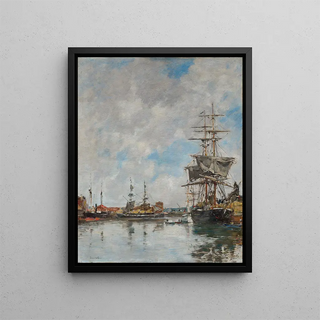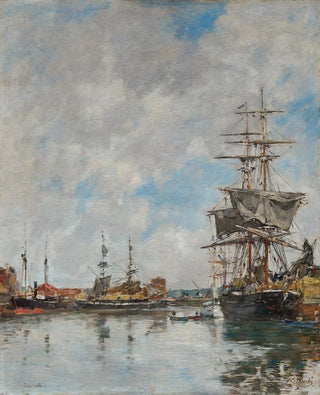Art print | The Deauville Basin - Eugène Boudin


View from behind

Frame (optional)
The Bassin de Deauville - Eugène Boudin – Captivating Introduction
In the fascinating world of Impressionism, "The Bassin de Deauville" by Eugène Boudin stands out for its lightness and delicacy. This artwork, painted in 1869, transports the viewer to the heart of a maritime scene where the sky is reflected in the calm waters of the basin. Light plays a central role, illuminating the sails of the boats and the faces of the strollers lingering there. Contemplating this art print, one can almost feel the breath of the wind and the salty scent of the sea, inviting a sensory escape. This painting is not just a simple representation; it evokes an atmosphere, a time period, and a way of life in harmony with nature.
Style and uniqueness of the work
Boudin, recognized for his mastery of cloudy skies and aquatic reflections, here manages to capture the very essence of the Norman landscape. The color palette used is subtle, oscillating between soft hues and luminous highlights, creating a perfect balance between shadow and light. The brushstrokes, both precise and free, inject a dynamic quality into the scene, making the movement of clouds and waves almost palpable. The choice of composition, with a richly detailed foreground and a background that fades, guides the eye and invites exploration of every corner of the painting. It is this ability to combine technique and emotion that gives "The Bassin de Deauville" an undeniable singularity, making this art print a must-have in the artistic heritage.
The artist and his influence
Eugène Boudin, often considered one of the pioneers of Impressionism, knew how to mark his era with his innovative approach to plein air painting. Born in 1824 in Honfleur, he was deeply influenced by the light and landscapes of the Normandy coast. His friendship with artists such as Claude Monet also contributed to shaping his style, while allowing him to explore new techniques. Boudin played a decisive role in the development of modern art, encouraging his contemporaries to step out of their studios and paint directly on site. His unique vision and

Matte finish

View from behind

Frame (optional)
The Bassin de Deauville - Eugène Boudin – Captivating Introduction
In the fascinating world of Impressionism, "The Bassin de Deauville" by Eugène Boudin stands out for its lightness and delicacy. This artwork, painted in 1869, transports the viewer to the heart of a maritime scene where the sky is reflected in the calm waters of the basin. Light plays a central role, illuminating the sails of the boats and the faces of the strollers lingering there. Contemplating this art print, one can almost feel the breath of the wind and the salty scent of the sea, inviting a sensory escape. This painting is not just a simple representation; it evokes an atmosphere, a time period, and a way of life in harmony with nature.
Style and uniqueness of the work
Boudin, recognized for his mastery of cloudy skies and aquatic reflections, here manages to capture the very essence of the Norman landscape. The color palette used is subtle, oscillating between soft hues and luminous highlights, creating a perfect balance between shadow and light. The brushstrokes, both precise and free, inject a dynamic quality into the scene, making the movement of clouds and waves almost palpable. The choice of composition, with a richly detailed foreground and a background that fades, guides the eye and invites exploration of every corner of the painting. It is this ability to combine technique and emotion that gives "The Bassin de Deauville" an undeniable singularity, making this art print a must-have in the artistic heritage.
The artist and his influence
Eugène Boudin, often considered one of the pioneers of Impressionism, knew how to mark his era with his innovative approach to plein air painting. Born in 1824 in Honfleur, he was deeply influenced by the light and landscapes of the Normandy coast. His friendship with artists such as Claude Monet also contributed to shaping his style, while allowing him to explore new techniques. Boudin played a decisive role in the development of modern art, encouraging his contemporaries to step out of their studios and paint directly on site. His unique vision and






